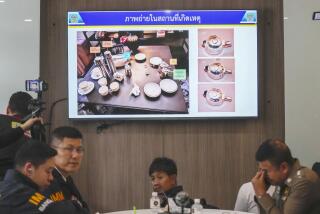Frustration Near the Boiling Point for 165,000 Cambodians in Thai Refugee Camp
- Share via
SITE II, Thailand — The flying noodle man is dead, stabbed by an old friend he attacked with an ax.
Phan Try, a popular local character known for the flamboyant way he tossed noodles in his food stall, was a victim of the growing frustration in this teeming camp for 165,000 Cambodians in the hot hills along the eastern border of Thailand.
Try, 52, was regarded as a mild-mannered man until something snapped during a trivial row with an old buddy in March.
“Idleness, fear, general paranoia, bandits, harassment, illicit taxes--it’s all weighing on them,” a senior foreign aid worker said. “Family crimes--wife-beating, suicide, rows and occasional killings--are the result.”
An American doctor, who has worked with the Cambodians on and off during the 1980s, said: “It used to be that neighbors would get mad and yell at each other. Now they attack each other.”
The camp is home for Cambodians who fled their country after the 1978 Vietnamese invasion. Many had already suffered in the bloody 3-year rule of the Khmer Rouge under Pol Pot, when hundreds of thousands died.
About a third of the inmates of Site II are under 9 years old, and most of these were born in a camp. For them rice and water originate in trucks.
An average of seven babies are born in the already crowded camp every day. “The only good thing that happens to these people is the birth of a baby,” the American doctor said.
For them and their parents, the only way out of the camp is to go home--and there is no way to do that until the powers that have a stake in Cambodia’s past and future agree on a way to end the fighting there.
Recent developments, including the start of a Soviet pullout from Afghanistan, talks between two Phnom Penh government and Cambodian guerrilla leaders, and a promise by Vietnam to remove its forces from Cambodia by 1990, raised some hopes.
But hopes have been dashed so often before that the Cambodians here, and another 140,000 scattered in other camps along the border, have no illusions about a quick return home.
The United Nations, which coordinates the relief operation, the International Committee of the Red Cross and Christian aid groups try to alleviate the misery and defuse the tension.
Relief workers say they have been encouraged by steps taken by the Thai authorities in the last eight months.
Most important has been a tacit acknowledgement of the failures of Task Force 80, the paramilitary organization set up to oversee security at the camps.
The organization has been accused by the Cambodians and aid workers of corruption and violence.
As part of the cleanup, a pair of much-feared Cambodians who established themselves as black market bosses and extortionists have been removed from the camp.
In the past the Thais forbade trading with the fenced, closed camp. They have now allowed a market on the edge of the camp, where Cambodians barter some of their rice or tinned fish rations for fruit, toothpaste, fresh fish or other goods.
But the underlying uncertainty and boredom remain.
Many youngsters are dragooned, or drift, into the armed guerrilla groups of the Cambodian People’s National Liberation Forces (KPNLF), to which the inmates of Site II are loyal.
Other camps along the border are allied with the Khmer Rouge, the biggest Cambodian fighting force, or the army of Prince Norodom Sihanouk. The Cambodian refugees along the frontier are their informal constituency.
More to Read
Sign up for Essential California
The most important California stories and recommendations in your inbox every morning.
You may occasionally receive promotional content from the Los Angeles Times.













